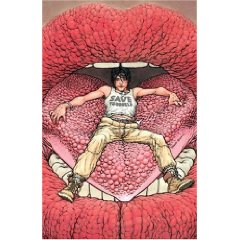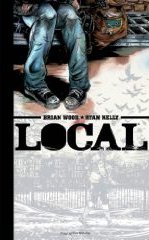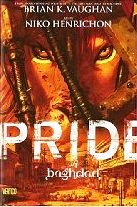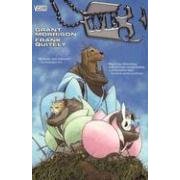American Virgin vol. 1: Head
August 28th, 2009
Writer: Steven T. Seagle
Artist: Becky Cloonan.
Reviewer: Louise
“American Virgin” is an interesting little tale, with probably the best title for a new comic I’ve seen in some time. It tells the story of Adam Chamberlain. The son of a fervent right-wing Christian in the US, Adam is the likeable poster boy for a Christian movement promoting chastity among teenagers, going on TV and giving interviews about how he and his girlfriend are going to wait until marriage. Despite scuffles with his cousins (who definitely aren’t Christian), and arguments with his brother (who definitely isn’t chaste), Adam is fundamentally happy with his life, including his friendship with his smart-mouthed (and also not chaste) female cousin. Until his girlfriend is kidnapped whilst volunteering in Africa, and Adam must venture there in search of her…
This is an interesting, if slightly flawed story. It’s a very good set-up; it’s probably a safe bet that many of the readers of “American Virgin” aren’t going to share Adam‘s outlook on life, yet he himself is quite a likeable individual – not perfect, but sincere in his views; he wants to have sex with his girlfriend, but believes they should wait. There’s an ongoing tension there that the story could exploit. Do we, as readers, want to see Adam change his views? The abstinence movement in America isn’t a topic I’ve seen addressed in comics before, and seeing it explored through the experiences of a character we can empathise with would be good, particularly since his cousin’s and brother’s viewpoints are sufficiently different to provide a contrasting outlook. And let’s face it, the “will they? won’t they?” erotic tension plotline is a tried-and-true way to keep the reader’s interest.
Unfortunately, once the plot moves to Africa these potentially interesting issues get sidelined. Whilst yes, it is interesting to see how Adam copes with a very different culture (whilst at the same time trying to cope with what he learns about along the way), it did feel rather like a remix of two very old plots: the hackneyed “white man finds his beliefs challenged in the darkest continent” plot and the standard blockbuster “man tries to rescue his girlfriend” plot.
Overall, though, it is an interesting read with high quality artwork by Becky Cloonan, and, as it’s an ongoing series, there’s room for the characters to develop and the issues to be explored. Recommended.
Paperback: 112 pages
Publisher: Vertigo (Nov 2006)
ISBN-10: 1401210651


